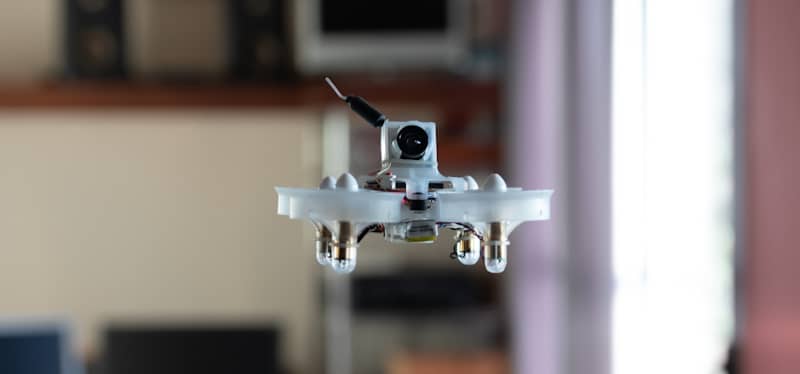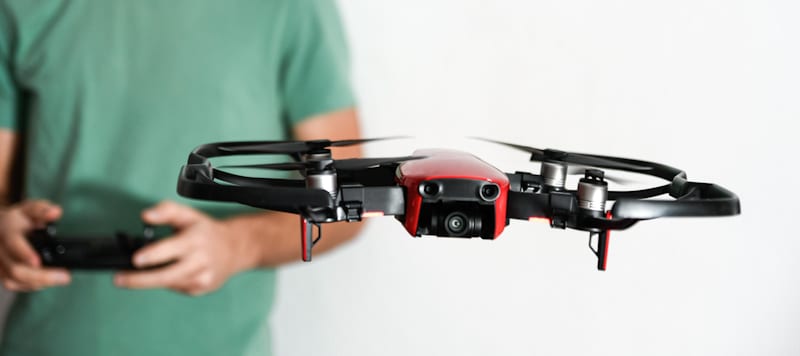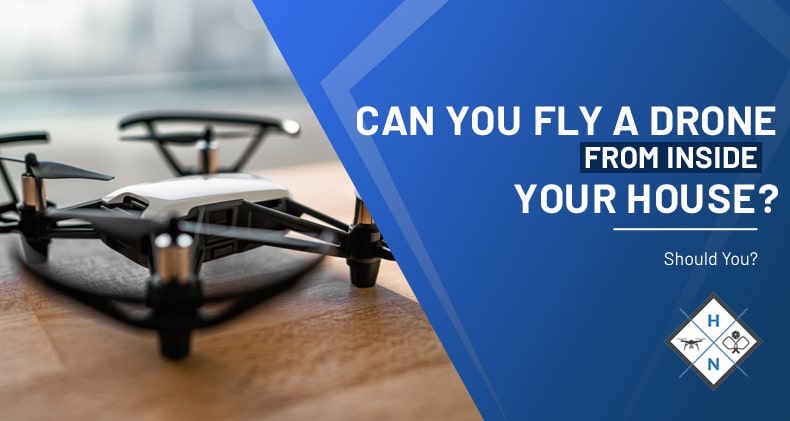Drone usage laws vary across countries, with most being prohibitive. Drone laws and guidelines in the U.S. are particularly quite stringent. So, what do the rules say about flying a mini aircraft from inside a house?
You can fly a drone from inside your house, and the rules are relaxed on the same. But the same is not advised since the flight experience would likely not be ideal. Lost signals, limited vision, etc., will be huge concerns. And if you cannot keep a constant eye on the drone, the FAA might come in.
Flying a drone inside a house or from within a house are two different things. If you'd like to learn more about it, the rules about flying a quadcopter with your house as its base, and more, keep reading.

Flying a Drone from Inside Your House
As stated above, flying a drone from within a home is undoubtedly possible – whether you live in a condo or an apartment. But it's not recommended.
For starters, the range will be limited, or you'll not be able to fly the drone as far as you usually can. Loss of signal or connection between the drone and its controller is quite possible, causing the drone to crash.
However, you could remedy the situation by mounting an antenna outside your house and using some solid cable. But that would mean some serious work. You might as well wait until the conditions outside are ideal for flying a drone.
The range of vision would be a problem, particularly if you launch the drone through your window.
Most houses in the U.S. have shingled sloped roofs. If those roofs were easily accessible, flat terraces instead, things would have been a lot more convenient. You can even launch the drone from your backyard or the front garden, but then that would technically be operating the drone from outside your house.
Talking about the legality of operating a drone from inside your house, it's perfectly acceptable as per the law. The FAA controls the airspace in America. It also lays down the rules on locations you cannot launch a drone from, including most public and state parks, airports, busy streets, etc.
There is nothing mentioned explicitly about launching a drone from inside a private property, such as a house. It's, therefore, safe to assume that launching drones from a property you own won't be an issue.
But the FAA would be alarmed if you cannot properly see the aircraft from within your house. As stated above, keeping a watch on the drone through a window may not be ideal, particularly if you're not flying the drone straight.
Though flying a drone from within a property is not recommended, it may be the only resort at times. For instance, when it's cold outside and you don't have appropriate clothing and gear to counter the wintry conditions or just don't feel like heading out, launching a drone from inside a house makes perfect sense.
What About Indoor Drones?
Generally, indoor drones are mini aircraft for kids, usually those below 10. These drones may or may not come with a controller. The ones without a controller are operated by hand. These drones are smaller in size compared to traditional UAVs. Their controllers are relatively petite too. Due to their size, the drones pack in smaller batteries and, therefore, have shorter flight periods – usually not more than 10 minutes.
UAVs meant for indoor use usually have their intended nature of use mentioned on their product packaging. If the box doesn't have the terms "indoor" or "inside" mentioned, the drone is not meant to be used within a physical space.
Don't try to operate mid- or regular-sized drones indoors as they could feel constricted, and you may end up crashing them. You can use outdoor drones inside only if the enclosed space is ample, such as at a tradeshow or a large warehouse.
That said, if you are pretty confident of your drone piloting skills and the indoor space is not massive but not too limiting at the same time, you could use regular drones like the DJI ones indoors. In other words, even drones designed for the outdoors could be used inside an enclosure if you can skillfully handle them.
The Benefits/Use Cases of Indoor Drones
As alluded to above, not all indoor drones are meant for kids. Based on the indoor space available, regular drones can also be operated within confines. For instance, drones used for industrial works such as 3D mapping and inspections are typically used indoors.
These drones help collect visual information for inspection reasons without the need for expensive scaffolding. Indoor drones are also used to access sites or get visuals of sites that cannot be reached otherwise.
Also, drones cannot be used outdoors during snow, after sunset, or when there's a lockdown in effect. Drones used inside will have none of these concerns. Not to mention, these indoor drones help with learning to fly a drone before you could take the plunge outside.
Perhaps, the most underappreciated aspect of flying an indoor drone is you do not require FAA authorization. Irrespective of whether you are flying the drone for fun or a commercial project, or what kind or how large the drone is, you may fly a drone with no FAA nod as long as you keep the activity indoors.
But do not quote us on this. Since the FAA keeps updating its rules, you'd be better off checking with the governmental body before flying your drone indoors.
The Drawbacks to Indoor Drones
If you're going to use a regular drone inside, make sure the physical space offers some breathing space for the aircraft. Even if you are an expert drone pilot, you could have only so much fun when the physical space is limiting.
Drones designed for indoor use usually are lacking in the features, performance, and battery department. Unless the drone is for kids or some industrial work, indoor drones aren't feature-packed or versatile.
Not to mention, indoor drones come with obstacle avoidance features that could hinder the flying experience. The drone's crash avoidance capabilities could render it so sensitive that the mini aircraft may not even pass through a fairly large doorway at times. Flying the drone too close to ceilings and the ground would also impact the drone's stability, thanks to the massive amount of air generated by the aircraft's propellers during flight.

Is Flying a Drone in Residential Areas Legal?
The thought of hearing a drone, let alone witnessing it, is something most people despise. The mini aircraft is bothersome, intimidating, and can pose major privacy concerns – thanks to the cameras and the lenses they could come equipped with. In a residential area, the mere thought of a flying object capturing videos can make naive people feel insecure.
This begs the question, "Is it legal to fly a drone in residential areas?". Yes, it is not "illegal". The FAA controls the airspace above your house, and property parameters usually do not expand into the sky.
Unlike rights over an estate, property owners have little to no control or ownership of the air above or surrounding their house. Even valuable resources or objects later discovered underground do not belong to the person who owns the land above them.
Therefore, your rights to prevent drones from flying near or above your property are limited. The only exceptions are if the drone harms you physically or comes in direct contact with your property, or crashes on your land.
Can You Shoot Down a Drone?
To reiterate, you cannot do much legally even if a UAV is flying only a few feet above your backyard. And this includes not shooting down a drone. Doing so will put you in the wrong.
As per the NTSB (National Transportation Safety Board), a drone is an aircraft, and it's safeguarded like regular airplanes. The law that prohibits shooting down a Boeing 747, for instance, also comes into effect for drones. In short, a drone is considered an aircraft as per the law, and an aircraft cannot be taken down – irrespective of how small it is.
Taking a drone out is illegal even if you suspect the drone is recording your activities in your backyard. When you are in the open, you enjoy no privacy. But if a drone is recording you while you're inside your house, you have legal recourse.
There are also safety issues to consider when shooting a drone down—rechargeable lithium-polymer (lipo) batteries power quadcopters. If you shoot a drone and the bullet tears into the battery, the power pack could catch fire. And if the ablaze drone falls right over your property, it could burn your house with it.
Also, the drone's owner has rights of their own. If you damage the mini aircraft, the owner of the UAV could drag you to court.
Choices You Have When You Don’t Want A Drone Near Your Property
If the drone pilot is your neighbor, it's critical not to overreact or respond angrily as that could lead to unnecessary tensions between the two of you, eventually turning into a feud. The last thing you want is to get booked for unruly behavior or physical assault.
Knock on their door or reach out to them via phone or email. Request the individual not to fly their drone over your house. Perhaps your neighbor didn't know you noticed the drone or the mini copter annoyed you in the first place.
Upon realization, most drone pilots will agree to refrain from using the drone anywhere near your property. They'll stick to their backyard or head to a public park where it's supposedly legal to fly a drone. If your property is not fenced correctly, the drone user may have inadvertently flown the drone over your house.
Even if the drone pilot is not your neighbor, just communicating the message will get the job done. Also, since drones have a limited range and a short flight time, the drone pilot is likely to be somewhere in the locality. Finding the person should, therefore, not be an issue.
But if your neighbor or not-your-neighbor doesn't respond to your calls of distress amicably, you may take them to court on charges of causing a nuisance in the locality. The drone's noise is a "nuisance" in this context. Just the mere thought of an impending lawsuit will force the drone user to cease their operations, whether they like it or not.
If you believe the drone is spying on you, call the cops. The "nuisance" mentioned above or "Peeping Tom" laws could apply.
You may also file a trespassing case. You may not own the immediate airspace above or near your property, but infringement of it is still violating your rights to live in peace and calm.
If you can grab pictures of the drone flying close to your window or yard, submit those images to the court, and the judge would most likely consider that as trespass and rule the case in your favor.
Kindly note, even if you manage to win the case for breach of privacy or trespassing, the damages you'll receive are likely to be nominal. Unlike in cases where you could sue an individual or entity for property destruction or breach of contract, the financial harm attached to a drone entering airspace right above your property is not easy to quantify.
Therefore, if the drone didn't harm you or your property, sort out the issue outside the court. If getting financial compensation for the trouble is the objective behind moving court, you could be in for a disappointment.

Conclusion
Drone technology is relatively new, and legislations have not caught up with them, quite expectedly. The FAA (Federal Aviation Administration) has regulations currently in place to minimize risks attached to flying drones or the risks of harming property and people on the ground. But there is nothing specifically mentioned about flying drones from inside a house or over residential areas.
Moreover, the rules in place exempt recreational drone pilots and hobbyists to a large extent. If you are worried about a drone flying in your neighborhood, the drone likely belongs to a recreational pilot. And there's nothing much you could do about legally. However, there are resources, as clearly stated above. Most importantly, never lose your composure when tackling rogue drones.
Shawn Manaher loves to play with new toys and dive into new hobbies. As a serial entrepreneur, work definitely comes first but there is always room for hobbies.

